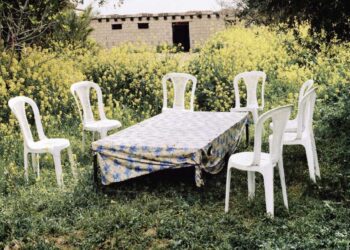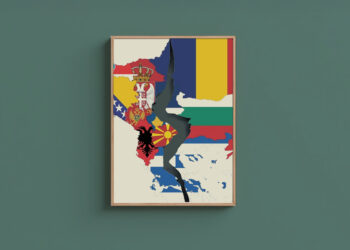“It becomes a vigorous and prearranged promulgation of the status quo. The culture industry tends to make itself the embodiment of authoritative pronouncements, and thus the irrefutable prophet of the prevailing order. It skillfully steers a winding course between the cliffs of demonstrable misinformation and manifest truth, faithfully reproducing the phenomenon whose opaqueness blocks any insight and installs the ubiquitous and intact phenomenon ideal.” [1]
Labor and capital are crucial for all industries. This includes the cultural and artistic industry. In the case of Berlin, having been marketed as a globally diverse and artistic city, artists became crucial to maintain such an image to keep its central position in the “art world” as well as uphold its economic proliferation through the music and cultural industry[2].
Labeling and categorization as well as commodification processes are key for prolonging this constructed image of a “cultural center”. But how did it reach this point? Why has it become attractive to this high number of artists from all over the world?
After the Berlin wall fell, Germany entered a new phase that fostered new challenges. During the 1990’s Berlin policies adopted were meant to achieve rapid economic growth in a short period of time. However, this was based on a groundless optimistic boom scenario, and many real economic and social problems were ignored. Unemployment was at 20%, while the unemployment rate of the second generation of most immigrant groups, who had come mostly as “low-skilled” industrial workers, reached 40%[3]. Moreover, the rapid unification, led to a top-down strategy to integrate German refugees and expellees, which was a one-way process based on West German terms[4]. Germany and more specifically Berlin, was in desperate need for economic revival, to be able to integrate expellees, refugees, as well as immigrants from other countries. This crisis had turned Berlin into a fertile ground for dynamic urban cultures and a rise of subcultures took place which attracted international attention. Lanz (2010) plainly explains the situation and what followed,
“In the space of a decade, they ((sub)cultures) had developed into one of the few instances of economic potential in the city. In addition to the media and music industry, tourism was regarded as another hope for economic growth. By the end of the 1990s, crisis-ridden Berlin and its establishment began to lay claim to urban (sub)cultures as one of the few marketing opportunities for the city. Multicultural facets of the urban landscape of cultures were an important part of this strategy. Efforts to style Berlin as a cosmopolitan metropolis and the growing ‘festivalization’ of urban policy began to incorporate specific elements of immigrant cultures. Public discourse henceforth increasingly distinguished ‘good’ (utilizable) from ‘bad’ (potentially disturbing) cultures. In particular, the ‘Carnival of Cultures’ evolved into a symbol for the economic and social potential of the multicultural metropolis: for the first time, in May 1996, this street parade took place in Berlin–Kreuzberg”[5].
It was cultural diversity that was about to save the reunified German capital; the entry point to economic revival, where for the first time “outsiders” were the ones who would save the city. The carnival was a “workshop of cultures”, a “metaphor for a peaceful display of multiculturalism”[6]. However, the multicultural essence of the carnival was still under the German notion of clear cultural distinction. Opposing views are easily delegitimized, where those who did not participate were perceived as inferior in some way or another. There is selectivity in participation and representation of different cultures. For example, “rather limited participation of ‘Turks’ or ‘Arabs’ – that is, Muslims – receives critical attention. These are perceived not as musicians but rather as representatives of their religion or their nation, being too traditionalistic and lacking in the happy-go-lucky required of a carnival”[7]. This approach to “diversity” creates a hierarchy of cultures, depending on how significant it is for German society, if given a status or position. Here, the significance is economic.
To further clarify, the “Carnival of Cultures” that was held in 1996 (and the cultural policies that followed) adopts a policy of “culturalization,” which leads to the classification of cultural diversity. This favors certain practices, while others remain invisible. This success that we see stems from its ability to serve two dominant principles of ethnic and cultural representation in Berlin, the first is the principle of “consumption of ethnic cultures” and the other is the “integrating space” that transforms ethnic culture into a social culture (socio-cultural) to cover up social problems. The first law concerns the exoticism of immigrants, while the other leads to the use of culture as an instrument for social and political goals. Culture, on the one hand, is politically charged with somewhat utopian expectations in this case, and on the other hand, it is symbolically relegated to a secondary or worldly status by virtue of its use as a means of integration into social and cultural action[8]. This cultural view is based on the interest of the German economy and is a romantic and unrealistic idea. It is not sufficient to include the differences that exist within German society[9]. The cultural diversity present in the city becomes a tool for decision makers and those who dominate the cultural field to use as needed, politically, socially, or economically. This is currently being put into use within the field culture and art given the genocide in Gaza. The stronger the position of the “culture industry” in a certain society, the more it can control and tame the needs of consumers. It turns into a tool of control and domination, while embodying the statements and trends of the prevailing political regime[10].
This is where selectivity, and the role of labeling and categorization is important. Giving the ability to choose who is part of this culture/carnival, or who is supported and highlighted to be part of the global and multicultural image of Berlin and who is not. Who is part of the brand image that is to be marketed to keep the economy of Berlin running after it has been revitalized as we mentioned. The musicians who are “accepted” and given spaces, venues, support, opportunities and considered part of Berlin’s musical space, are selectively chosen based on what is considered “suitable” or what fits the German “model.” This was evident with the arrival of Syrian artists and musicians to Berlin (2015-2016). There were always attempts to classify them on a legal or ethnic basis, labels such as “refugee music” or “oriental music”, changing band names on flyers into “refugee rockers” or “refugee musicians”. In this way, new markets are created, and certain aspects of cultures can be commodified (disassociated from their social, political, and historical significance) and marketed for consumption by Berliners becoming profitable for the city. This is a relation of coloniality, that is the “patterns of power in the sphere of knowledge production and culture” rather than politics[11], these power dynamics create monopolies and relations of dependency that guarantee capital flow towards a city such as Berlin (in this case musicians or artists).
For example, when talking about the Asian diaspora in London, Banerjea (2000) explains how one of the functions of the capitalist system is to transform different cultures and works of art into commodities as neoliberal consumer markets need to be constantly fed with new “products” through marketing and advertising in order to benefit from specific productions while disassociating them from any political, cultural or social contexts or significance, which were the circumstances that led to these productions. This is usually done through labelling and categorization processes, which depend on identities or legal status. In this way, new subcultures or genres can emerge in the context of music leading to new consumer markets, where related ‘products’ can be advertised and thus profited from[12]. This also occurred with Rai music in France, where it was transformed from music for the populus in Algeria and other countries into an entertainment commodity that reproduces societal and class hierarchies against Algerians and Moroccans in Paris[13]. This exploitive relation can also be seen in western club culture and specifically Paris, as stated in an important article entitled “Negrophilia in Club Culture”[14], highlighting how “modern-day clubs in the West are venues in which white people get to interact for a night with Black performers, and develop parasocial relationships with the very same Black patrons and entertainers who are denied housing, jobs, and so on, outside of the dancefloor”.
Going back to Berlin and the arrival of Syrian artists[15], which was after the borders were opened in 2015 while Angela Merkel was the head of the German government. It is important to stress that this decision was not humanitarian or caused by “refugees” stranded on the borders of Europe. Rather, it was an economic decision due to the need for labor. According to German figures, by the year 2050 there will be no German labor force due to low birth rates and an aging population. It was a strategic political-economic move; the German society needed labor. Here lies the importance of processes of classification and commodification of cultures, as well as artistic productions, and artists themselves, in the field of culture and art. Typically, border and immigration authorities control who enters the country, through issuing visas, skilled migration initiatives etc. However, the adoption of an open-door policy hampered this process, people arriving to Germany could not be “filtered” by immigration agents and authorities. This leads dominant actors who hold dominant positions within the field of culture and arts to feel insecure about their social positions (and markets) because they might be at stake. This is due to the presence of newcomers to the musical space, who may be able to “transcend the dominant mode of thought and expression” or change the dominant narrative of the cultural field or even alter the or expand the opportunities available[16]. In that way newcomers (Syrian musicians in this example) are labelled and limited to specific categories that restricts them to specific types of music, specific venues, and specific concerts, consequently specific markets related to the classification in which they are placed.
These labelling processes provide a way to limit access to different markets and consumers, and those who hold dominant positions in Berlin in this field can maintain and strengthen their positions by confining newcomers within a specific label that is unrelated to their own and thus keeping them out of their own markets and creating new ones. This is also an attempt to relegate such cultural productions to a certain level (high/low art, underground, alternative) limiting its influence or participation in the “dominant” culture, maintaining the cultural hierarchy as mentioned above. Certainly, this is not a fixed process, there are exceptions and, to some extent this could be countered through collective efforts. This could be seen as a process of “negotiation”, in this case, Syrian musicians did not submit to the classification process, rather resisted it in multiple ways. Boycotting events that place them under a specific label such as refugees or Easterners was one way. Building independent platforms through which they can produce and release music, in addition to artistic collectives and platforms that address and oppose identitarian and racial classifications. We are also currently witnessing this, with the genocide in Gaza, even though challenging, platforms and collectives emerging through artist organizations have an impact through collective organizational efforts. If not on the short, on the long run.
Upon arrival to Berlin, labelling and categorization processes have another role other than limiting newcomers to specific markets, commodification, and profit. Standardization and conformity are another function. Many musicians who arrive in Berlin are pushed towards becoming DJs despite their ability to produce and compose (the same happens with non-artist immigrants who are pushed into manual labor by not recognizing their degrees or not creating a talent or skill pool, like they did for Ukrainians for instance). This is an understandable path for musicians because the market is massive and those arriving need financial stability and to make ends meet, not forgetting the heaviness of the migration process itself. In the context of Berlin’s current cultural structure, this is a way to keep this market and the nightlife economy alive and running in the city. This is how capital and labor are provided for this industry, and even if the musicians while DJing can include inspiration from their own culture or identities which they want to represent, they will end up combining it with local sounds that are mostly Western sounds, samples, and notes. In this way, the structure (if not directly) within the music industry creates standardization and conformity of artists to keep the market going and the cultural economy well-fed.
Once an artist or group of artists begin to differentiate themselves through their music and based on their own culture, identity, or even begin a process of constructing/creating a new musical/cultural identity, given their experiences, creating a new narrative that challenges the “dominant,” “national,” or “Berliner” narrative, is going to be seen as disruptive due to influencing the current environment, and with time might transcend the dominant pattern of artistic or cultural production, changing the power dynamics within the cultural field. There are certain types of cultural capital that are seen as valuable and legitimate, that are used to reproduce and reinvent the existing culture as well as structure, while another is seen as disruptive.
In other words, within a capitalistic system and neoliberal consumer markets, along with western monopolies over cultural resources and means of production as well as the post-colonial and inferior outlook towards the rest of the world, not forgetting oppressive post-colonial regimes established in many countries around the globe, artistic and cultural production is dealt with either as a political tool or an industry made up of capital, labor, and profit. The current structure devastated (not all of course but to a certain extent) cultural and artistic productions that are genuine, critical, or constructive which could influence or critique. At any instance that a certain production could break or change the dominant narrative or deal with political, social, and cultural issues, it is not supported and relegated to underground music, or limited to a certain market or space within the cultural field. It is contained.
We see this in core European cities, which does not only apply to the arts but all types of capital. In the end, they see us as nothing more than capital that can be exploited to consolidate their positions and reproduce the hegemony stemming from colonial and economic history. Funding opportunities, artistic residencies, performances, support programs, and different spaces that are attractive for artists and most people, are available, but we must speak their language, and stay within their narrative. We have freedom here, but with a ceiling. If we break this ceiling, we become an obstacle to them, or more accurately, enemies. Because we appeared as we are, not as they see us. This is what we see very clearly with the Palestinian issue given the genocide in Gaza (and certainly the rest of Palestine). From the state and cultural organizations to concert venues and artistic platforms that claimed justice and openness, have attacked, criminalized, banned, and canceled artists who support this cause.
Similar to dealing with the Palestinians in Germany, where it is possible to live in Berlin, if we conform to the German perspective, their narrative, and outlook. If Palestinians appear in Berlin with their own narrative, perspective, and outlook, they will be suppressed. If they are invisible and produce for the German economy and do not disturb the regime, it is acceptable (and the Palestinians are truly hidden, even in the state numbers it says “unknown” or “stateless”), otherwise you are not welcome. This applies to art and artists. If art can be commodified and promoted in the cultural market and does not disturb the mainstream approach, it is accepted and highlighted. This is the distinction between “good” (usable) cultures and “bad” (unusable) cultures, which contradict the narrative and consequently becomes an obstacle to this society, its policies, and institutions.
[1] Theodor Adorno & Max Horkheimer, Dialectics of Enlightenment (Verso, 1997), p. 147.
[2] Berlin’s cultural budget for 2024 is 947m Euros. Berlin’s new culture budget more than double England’s arts funding | Euronews
[3] Stephan Lanz, “The German Sonderweg: multiculturalism as racism in distance,” in: Sili Alessando, European Multiculturalism revisited (UK: Zed Books, 2010), p. 128.
[4] Douglas Klusmeyer, “A ‘guiding culture’ for immigrants? Integration and diversity in Germany,” Journal of Ethnic and Migration Studies, vol. 27, no. 3 (2001), p. 528.
[5] Lanz, p. 129.
[6] Ibid.
[7] Ibid., p. 130.
[8] Ibid.
[9] Klusmeyer, “A ‘guiding culture’ for immigrants.”
[10] Adorno & Horkheimer, pp. 144, 147.
[11] Kevin Ochieng Okoth, Red Africa (Verso, 2023), p. 12.
[12] Koushik Banerjea (2000), “Sound of Whose Underground? The Fine Tuning of Diaspora in the Age of Mechanical Production,” Theory, Culture & Society, vol. 17, no. 3, pp. 64-79.
[13] Joan Gross, David McMurray & Ted Swedenburg, “Arab Noise and Ramadan Nights: Rai, Rap, and Franco-Maghrebi Identity,” Diaspora: A Journal of Transnational Studies, vol. 3, no 1 (Spring 1994), pp. 3-39.
[14] Negrophilia in club culture – Technomaterialism.
[15] Perhaps it is beneficial to highlight the cultural importance of Syria and the region. The region’s (Levant) history is culturally and musically wealthy across centuries. Syria is considered a cultural container holding more than 38 civilizations that have either originated or passed through the region leaving some kind of cultural impact. For example, the “first” musical piece found was in Syria in Ugarit (Latakia presently), as well as the first singer in written history, Ornina, found in kingdom of Mari (close to Deir El Zour presently). Germans are fully aware of this cultural richness this is why there are always excavation teams sent to the region (as well as Egypt and other regions for example), this is also why German museums are packed with artifacts originating from the Levant, Africa, and many other previously colonized regions.
[16] Pierre Bourdieu, The Field of Cultural Production (Columbia University Press, 1994), p. 31.
*The article was originally published in Arabic in Fus7a Magazine.








